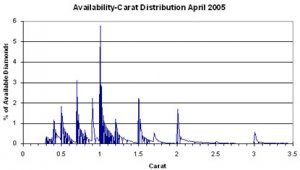- Joined
- Aug 15, 2000
- Messages
- 18,461
The existing Tutorial is here:
http://diamonds.pricescope.com/carat.asp
Here is a start - please feel free to slander and slash
 my pathetic attempt
my pathetic attempt
Carat is the simplest and only truly objective of the four C''s. Pop a diamond on the scales, if it weighs 0.2 gm then it is a 1.00 carat diamond. 1/4ct is often called 25 points.
Everyone knows more Carat weight means more cost. But the surprise is how much more BIG diamonds cost; if you double the weight then the cost is about 4 times more.
The magic 1.00ct D color Flawless costs 1.7 times more than a 99 point or 0.99ct D Flawless. Naturally diamond cutters must achieve the ‘magic weights'', even if that means compromising Cut quality – the sparkle factor.
You might think Carat weight equals size? Wrong! The two diamonds in the picture on the right have the same diameter, and each could be cut from the rough diamond in the centre. But because of the weight of the dull stone on the left it will sell for more than the sparkly one.
It is just so tempting for a cutter to leave a little more weight on the crown and pavilion (the top and the bottom) to push the stone to the next ‘magic weight''. On Pricescope you will learn about tools like HCA and the Ideal-Scope; analysis of stones is often discussed on the Rocky Talky Forum. Make sure you don’t pay for dead weight and get the millimeter spread you are paying for.
The magic weights are 1/2ct, 3/4ct, 90 points, 1ct, 1.5ct, 2ct etc. ‘Under-sizes'' are diamonds that weigh just below a magic weight; they can be a bargain, but there are a lot less to choose from.
The girdle or edge thickness is also important. If a diamond has no girdle, or it is very thin, the stone can have a better spread, but it will chip easily. Medium to slightly thick girdles are safest, but thicker girdles add extra weight or reduce the spread.
To get an idea about the range of spreads for different weights, search the Pricescope vendors in-house diamonds listed and you will see a value next to the price on the far right. Say a 1ct Princess cut is listed at -10% - that means it has the same spread as 0.90ct text book round diamond.
http://diamonds.pricescope.com/carat.asp
Here is a start - please feel free to slander and slash

Carat is the simplest and only truly objective of the four C''s. Pop a diamond on the scales, if it weighs 0.2 gm then it is a 1.00 carat diamond. 1/4ct is often called 25 points.
Everyone knows more Carat weight means more cost. But the surprise is how much more BIG diamonds cost; if you double the weight then the cost is about 4 times more.
The magic 1.00ct D color Flawless costs 1.7 times more than a 99 point or 0.99ct D Flawless. Naturally diamond cutters must achieve the ‘magic weights'', even if that means compromising Cut quality – the sparkle factor.
You might think Carat weight equals size? Wrong! The two diamonds in the picture on the right have the same diameter, and each could be cut from the rough diamond in the centre. But because of the weight of the dull stone on the left it will sell for more than the sparkly one.
It is just so tempting for a cutter to leave a little more weight on the crown and pavilion (the top and the bottom) to push the stone to the next ‘magic weight''. On Pricescope you will learn about tools like HCA and the Ideal-Scope; analysis of stones is often discussed on the Rocky Talky Forum. Make sure you don’t pay for dead weight and get the millimeter spread you are paying for.
The magic weights are 1/2ct, 3/4ct, 90 points, 1ct, 1.5ct, 2ct etc. ‘Under-sizes'' are diamonds that weigh just below a magic weight; they can be a bargain, but there are a lot less to choose from.
The girdle or edge thickness is also important. If a diamond has no girdle, or it is very thin, the stone can have a better spread, but it will chip easily. Medium to slightly thick girdles are safest, but thicker girdles add extra weight or reduce the spread.
To get an idea about the range of spreads for different weights, search the Pricescope vendors in-house diamonds listed and you will see a value next to the price on the far right. Say a 1ct Princess cut is listed at -10% - that means it has the same spread as 0.90ct text book round diamond.









300x240.png)